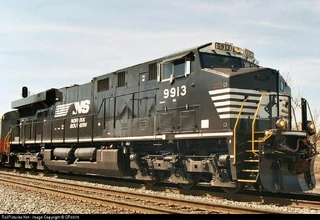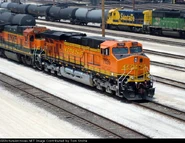Bio[]
The GE (General Electric) ES44DC is a type of six-axle, 4,400hp diesel locomotive built from 2004 to 2010 (first introduced in 2003) with a total of at least 1,368 built. The model is part of GE's "Evolution Series" (otherwise known as a "GEVO").

A typical CSX ES44DC (now classified as an "ES40DC").
Despite having an initial debut in early-2003, the model didn't officially begin production until the US EPA's "Tier 2" policy became under full effect in 2004-2005. And because of the debut of its AC-traction counter-part; the more popular ES44AC, orders weren't placed until the following year due to a lack of interest from most railroads whom preferred AC-traction motive power as opposed to the more traditional DC-traction power utilized since the dawn of diesel-electric locomotives in North America. In other words, the model didn't prove to be too popular or generate many orders except for with a handful of customers (notably CN, NS, and CSX).
BNSF Railway, CSX Transportation (CSX), Canadian National (CN), and Norfolk Southern (NS; having a 4,000hp variant known as the ES40DC) were among the original customers to order the model, while Pilbara Iron ordered their own specialized variant: the ES44DCi, which has an enlarged radiator section (vaguely similar to the AC6000CW) to increase cooling capacity for operating in the Australian outback.
Although originally rated at 4,400hp, CSX has since re-rated or converted their 4,400hp ES44DC units to 4,000hp ES40DC's in favor of utilizing their exclusive ES44AH's full 4,400hp potential. NS on the other-hand, has since re-rated their specialized ES40DC units to 4,400hp, therefore making them essentially true ES44DC's (similar to their recent Dash 9 conversion).
Like the ES44AC, the ES44DC is the initial successor to the C44-9W or Dash 9.
All are currently in service with their respective owners.
History[]
During the early 2000's, global warming awareness was in full-effect for all vehicles utilizing every known form of internal-combustion engine possible. Because of the ever-increasing amounts of smog, high fuel consumption, and skyrocketing fuel prices for most vehicles; the beginning of what was to come for today's economy, the US EPA began to establish "Tier" policies which required diesel powered vehicles (such as semi trucks, locomotives, dump trucks, etc.) to follow a strict set of rules, laws, and regulations regarding fuel consumption, operating costs, and emissions for vehicle manufacturing companies (as well as the companies which own and operate said vehicles). Although traditional gas-powered automobiles were in the process of undergoing similar policies to help reduce the effects of green house gases, the stakes were still high for the fuel economy in the coming years.

NS #9913 (now NS #7501) hauling a GE test train in 2004.
Unlike the automotive industry, the rail industry began to seek said energy-efficiency policies as a new way to improve on past mistakes made nearly a decade earlier in the 1990's. After the unfortunate failures of GE's HDL-16-powered AC6000CW and EMD's subsequent 265H-powered SD90MAC for the domestic North American diesel locomotive market (unlike nations like China and India), both companies decided to move on from their past mistakes by developing even more successful, revolutionary, and innovative diesel locomotive models with engines capable of reducing fuel consumption, emissions, and furthermore reducing operating costs. Hence, the ES44DC and ES44AC; along with the SD70M-2 and SD70ACe, were born: the successors to the preceding C44-9W and AC4400CW. Not only did both models succeed in following the US EPA's once-strict "Tier 2" policies, they had implemented far more advanced microprocessor computer control technology along with other features that nearly surpassed their predecessors.
In 2003, the first demonstrations for both the ES44DC and ES44AC were well underway and by 2004, the first GEVO units (being the AC44EV or "AC V12 Tier II" testbeds) were demonstrated to UP and BNSF upon completion during the previous months. In total, 54 pre-production GEVO units were built, and delivered to host railroads such as BNSF, UP, and NS. Despite having proved unsuccessful at first during the course of the earlier demonstration runs, the ES44AC still proved to be increasingly successful; yet not too favored with BNSF at first. Therefore, the railroad grew interested in ordering a total of 721 ES44DC units to accompany or accommodate their existing Dash 9 fleet and subsequently replaced their less-favorable and otherwise "outdated" C40-8W units from ATSF heritage for general revenue service (besides furthermore eliminating the need of old and tired 645-engined diesels like the SD40-2 and SD45-2 from EMD). The first ES44DC units (BNSF 5718-5747) were previously the early AC44EV pre-production ES44AC testbeds delivered between August 2003 and January 2004, but were eventually converted into what was dubbed as a "DC V12 Hybrid Locomotive", which became the first examples of ES44DC units on the road, but not actually produced. Rather, GECX #2011 became the first ES44DC assembled and built at Erie in April 2003, which further prompted orders generated from BNSF upon the successful demonstrations caused by the converted DC-traction ES44AC testbeds. The first production ES44DC's were soon ordered by BNSF and CSX in the following months of Norfolk Southern's (NS) 17 pre-production ES40DC testbeds.
As for the two primary Eastern carriers, CSX decided to purchase a plethora of units (302 total) to supplement their current fleets of active six-axle road units rather than resort to using their unfavorable four-axle units now currently utilized as yard units or for local service. NS, however, decided to order 220 ES40DC units for use alongside their existing C40-9 and C40-9W fleets. Many units (NS 7557-7616 and 7670-7719) are equipped for use in DPU (Distributed Power Unit) operation, and include LEADER or PTC (Positive Train Control) software to provide better safety through the use of the on-board desktop monitor displays.
CN ordered a total of 125 units for general revenue service, for they were in need of acquiring a new model to serve as an all-purpose machine.
For the Rio Tinto Group, a total of 51 units were delivered to the railway for use on the long and heavy ore trains in the Australian Pilbara region.
Unfortunately, due to the ever-increasing popularity with the AC-traction ES44AC and its A1A-trucked counter-part, there are currently no plans to resume production, nor have there been any orders generated from any customers for DC-traction diesels within the main or primary domestic locomotive market, for domestic DC-traction road locomotives have been almost entirely phased-out for the last decade in favor of AC-traction. Therefore, CN, BNSF, NS, and CSX (with the exception of Rio Tinto) have since ordered subsequent AC-traction ES44AC and ES44C4 units in favor of any additional ES44DC's.
Versions[]
ES40DC - NS' version of the original model (now CSX's designation for their original de-rated ES44DC units).
ES44DCi - Rio Tinto Group variant of the original (includes specialized cooling system for extreme heat conditions).
Confusion[]
The main way of distinguishing an ES44DC from other GEVO models is simply by the number series in which they are numbered by the four Class 1 railroads which own multiple versions of each model, and by a certain paintscheme variant.
- CSX usually paints distinct lightning bolts underneath the cab of their ES44AC and subsequent ES44AH units
- Most of the ES44AC (and AH) units owned by CSX are also equipped with radial self-steering trucks as opposed to the more common "hi-AD" trucks.
- Several earlier GEVO's delivered to CN were equipped with marker lights and included special windows (or windshields) to improve crew visibility reminiscent of their preceding Dash 9 units.
Like every other type or model of GE locomotive, the name is designated as follows:
- "ES" - "Evolution Series"
- "44" - 4,400hp
- "DC" - DC-traction or direct-current-powered traction motors.
Note*: CN classifies the ES44DC as a EF-644m per CN's classification system.
Trivia/Facts[]
Like its AC-traction counter-part(s), the ES44DC is equipped with standard or conventional controls as opposed to the more modern desktop style controls as featured on preceding wide-cab GE diesels like the C40-8W and AC4400CW.
CSX #5500 (an ES40DC) is currently one of the numerous "Spirit Of" units from within CSX's roster.
Ironically, like with the final Dash 9 units delivered to and received by Norfolk Southern, the company began receiving ES40DC units in primer grey paint with their respective numbers and owner reporting marks stenciled under the cab to fulfill a brief power shortage. Yet some units simply didn't receive their final paintwork until long after their assembly primarily due to increasing back orders at GE's Erie facility.
Rio Tinto's ES44DCi units are painted in two unique schemes: one being all grey (applied to units 8100-8118), the other being additional red lettering and striping (for units 8119-8150).
The first ES40DC units delivered to NS were originally numbered 9912-9916, and renumbered 7500-7504. Said former numbers now belong to their final orders of Dash 9's.
GECX #2011 is currently the only active demonstrator used at GE's Erie, PA facility for testing and evaluation purposes.
Gallery[]
Sources[]
http://www.nsdash9.com/rosters/7500.html

Cranking a GE Evolution locomotive for an outbound train-0
Starting of an CN ES44DC.
http://www.amazon.com/Locomotives-Modern-Diesel-Electric-Reference/dp/1554078962










